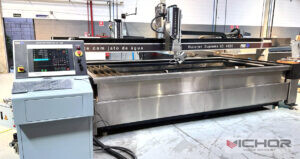
How Water Jet Cutting Sand Transforms Modern Manufacturing
Imagine slicing through solid stone, thick metal, or delicate composites with the sheer force of water. It sounds like science fiction, yet it’s a reality in today’s factories and workshops. At the heart of this technological marvel lies a simple, naturally occurring substance: sand. More precisely, the process known as water jet cutting sand is the unsung hero that empowers waterjets to perform these incredible feats. This article dives deep into the gritty details of this abrasive material, revealing how it turns a stream of water into an industrial-grade power tool capable of cutting almost any material known to man.
The Core Principle: What is Water Jet Cutting Sand?
At its core, a waterjet cutter is a tool that uses a high-pressure stream of water to cut materials. However, when that material is harder than metal or stone, pure water isn’t enough. This is where water jet cutting sand comes into play. Officially known as abrasive garnet, this material is introduced into the water stream after it has left the high-pressure nozzle.
The process works in two stages. First, a ultra-high-pressure pump, often operating at pressures exceeding 60,000 PSI, forces water through a tiny jewel orifice (usually made of diamond or sapphire). This creates a coherent, supersonic stream of pure water. Immediately after, this water stream is funneled into a mixing tube, where water jet cutting sand is drawn into the stream via a vacuum effect. The abrasive particles mix with the water, creating a potent erosive jet that can slice through materials many inches thick. It’s the combination of the water’s velocity and the sand’s hardness that makes the process so effective.
The Ideal Abrasive: Why Garnet is the Go-To Choice
Not just any sand can be used for this demanding process. The term “sand” is a bit of a misnomer; the most common and effective abrasive is garnet. This mineral is chosen for several key properties that make it the ideal water jet cutting sand.
Hardness: Garnet ranks 7-8 on the Mohs hardness scale, making it hard enough to abrade most industrial materials, including steel, titanium, and granite, without being so hard that it causes excessive wear on the machine’s components.
Sharpness: Garnet grains are naturally angular and sharp. This jagged structure allows them to act like millions of microscopic chisels, fracturing the material’s surface efficiently for fast, clean cuts.
Recyclability: Garnet is an environmentally inert material. While it’s typically used only once in the cutting head, spent garnet can often be recycled for other applications like sandblasting or as a traction material, reducing waste.
Consistency: For a reliable cut, the abrasive must have a consistent grain size and be free of contaminants. High-quality water jet cutting sand is carefully screened and washed to ensure uniform performance.
The Critical Role of Abrasive Feed Systems
The delivery of the abrasive to the cutting head is a precision operation. An inconsistent flow of water jet cutting sand would result in a poor-quality cut, with tapered edges and uneven surfaces. This is managed by the abrasive feed system.
This system typically consists of a hopper that holds the garnet, a metering device, and delivery lines. The system uses compressed air to precisely control the flow of abrasive into the mixing chamber. The goal is to create a perfectly saturated stream—just the right amount of abrasive mixed with the water. Too little abrasive, and the cutting speed plummets; too much, and it’s wasteful and can cause unnecessary wear. A well-designed feed system is crucial for maximizing the efficiency and cost-effectiveness of the water jet cutting sand.
Impact on Cut Quality and Speed
The type, size, and quality of the water jet cutting sand directly influence the final product. The “grit” size, measured in “mesh,” is a primary factor.
Fine Mesh (e.g., 80-120): Produces smoother surface finishes but may cut slightly slower. Ideal for detailed work and thinner materials where edge quality is paramount.
Coarse Mesh (e.g., 50-80): Cuts faster and is more aggressive, making it suitable for thick materials. The trade-off is a slightly rougher cut edge.
The consistent flow of high-quality abrasive ensures a straight, precise cut. Inconsistent or contaminated abrasive can lead to “striations” or drag lines on the cut edge, and can even cause the jet to deflect, resulting in a part that is not dimensionally accurate. Therefore, investing in premium water jet cutting sand is not an area to cut corners; it directly impacts productivity and part quality.

Economic and Environmental Considerations
While the initial cost of a waterjet system is significant, the operational cost is heavily influenced by the consumption of water jet cutting sand and replacement parts. Abrasive typically represents one of the highest ongoing costs in waterjet operation. This makes the choice of abrasive a key economic decision.
Using a lower-cost, inferior abrasive might seem like a way to save money, but it often leads to higher overall costs due to:
Slower cutting speeds, reducing throughput.
Poorer cut quality, leading to more post-processing or rejected parts.
Increased wear and tear on expensive components like the mixing tube and focus nozzle.
From an environmental standpoint, waterjet cutting is considered a “cool” process, meaning it generates no heat-affected zones or harmful fumes. The primary waste product is the spent water jet cutting sand and the material sludge. Many facilities now use water recycling systems to separate the water from the abrasive and cut material, allowing the water to be reused and the waste to be disposed of more responsibly.
Applications Enabled by Abrasive Waterjet Cutting
The addition of water jet cutting sand to the waterjet process unlocked a universe of applications that were previously difficult or impossible. It is this abrasive action that allows the technology to be used across a vast range of industries:
Aerospace: Cutting heat-sensitive composites, titanium, and aluminum alloys without compromising their structural integrity.
Architecture and Art: Precisely shaping intricate designs in marble, granite, glass, and metals for stunning visual effects.
Automotive: Prototyping parts and cutting gaskets, interior panels, and custom body components.
Manufacturing: Creating tools, dies, and machine parts from extremely hard metals.
Without the transformative power of water jet cutting sand, the waterjet would be limited to softer materials like rubber, foam, and food products.
Frequently Asked Questions (FAQs)
Q1: Can I use regular beach sand in a waterjet cutter?
A1: Absolutely not. Regular beach sand contains impurities, salts, and inconsistent grain sizes that would be disastrous for a waterjet system. It would cause rapid clogging and wear of critical components like the mixing tube and focus nozzle, leading to machine failure and poor cut quality. Only specially processed, industrial-grade garnet designed as water jet cutting sand should be used.
Q2: How much abrasive sand does a waterjet cutter use?
A2: The consumption rate varies significantly based on the material being cut, its thickness, and the desired cut quality. However, a typical abrasive waterjet can use between 0.5 to 2.0 pounds of water jet cutting sand per minute. This is why abrasive cost is a major factor in the operational budget.
Q3: What is the difference between garnet and other abrasives like aluminum oxide?
A3: While aluminum oxide is harder, it is also more expensive and causes faster wear on the machine’s components. Garnet offers the best balance of cutting performance, cost-effectiveness, and component life, which is why it is the industry standard for water jet cutting sand.
Q4: Why does the mixing tube need to be replaced, and how often?
A4: The mixing tube is where the high-speed water and abrasive mix. The constant erosion from the water jet cutting sand gradually widens the internal diameter of the tube. Once it becomes too wide, the jet loses its coherence and cutting power, resulting in tapered edges. Replacement frequency depends on usage and water pressure but can range from tens to hundreds of cutting hours.
Q5: Is the waste from waterjet cutting hazardous?
A5: Generally, the waste—a slurry of water, spent water jet cutting sand (garnet), and microscopic particles of the cut material—is not chemically hazardous. However, if you are cutting materials like lead or certain composites, the sludge may require special handling. Always consult local regulations for the disposal of industrial waste.
continue reading


